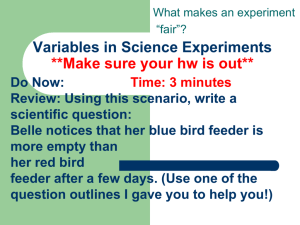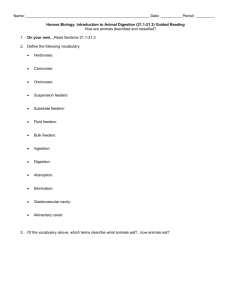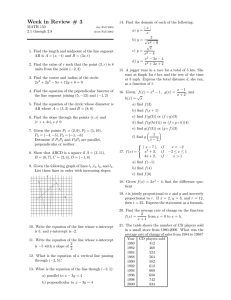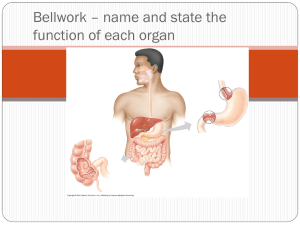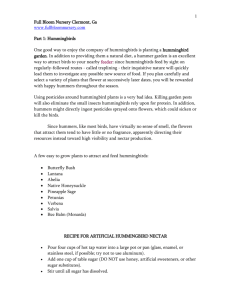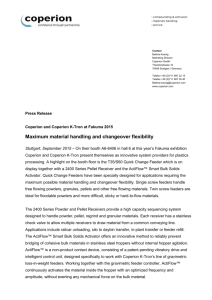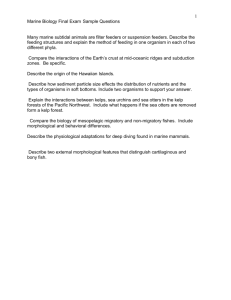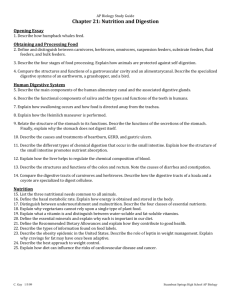COOPERATIVE EXTENSION NEWSLETTER u A
advertisement
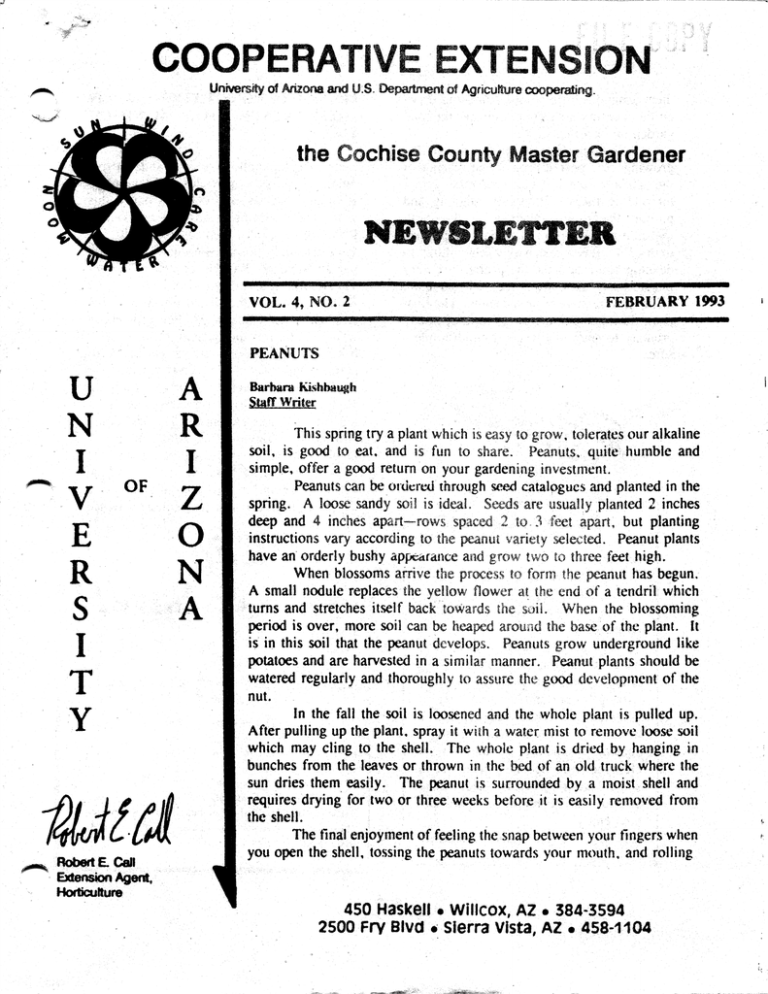
COOPERATIVE EXTENSION University of Arizona and U.S. Departmentof Agriculture cooperating. the Cochise Coyoty Master Gardener NEWSLETTER VOL. 4, NO. 2 FEBRUARY 1993 PEANUTS u N I V A R OF E R S I T Y I z o N A Barbara Kishbaugh Staff Writer This spring try a plant which is easy to grow, tolerates our alkaline soil, is good to eat. and is fun to share. Peanuts, quite humble and simple, offer a good return on your gardening investment. Peanuts can be ordered through seed catalogues and planted in the spring. A loose sandy soil is ideal. Seeds are usually planted 2 inches deep and 4 inches apart—rows spaced 2 to 3 feet apart, but planting instructions vary according to the peanut variety selected. Peanut plants have an orderly bushy appearaitce and grow two to three feet high. When blossoms arrive the process to form the peanut has begun. A small nodule replaces the yellow flower at the end of a tendril which turns and stretches itself back towards the soil. When the blossoming period is over, more soil can be heaped around the base of the plant. It is in this soil that the peanut develops. Peanuts grow underground like potatoes and are harvested in a similar manner. Peanut plants should be watered regularly and thoroughly to assure the good development of the nut. In the fall the soil is loosened and the whole plant is pulled up. After pulling up the plant, spray it with a water mist to remove loose soil which may cling to the shell. The whole plant is dried by hanging in bunches from the leaves or thrown in the bed of an old truck where the sun dries them easily. The peanut is surrounded by a moist shell and requires drying for two or three weeks before it is easily removed from the shell. Robert E. Can The final enjoyment of feeling the snap between your fingers when you open the shell, tossing the peanuts towards your mouth, and rolling Exlen^on Agent, Horticuiture 450 Haskell • Willcox, AZ • 384-3594 2500 Fry Blvd • sierra vista, AZ • 458-1104 them around a little before crunching down on them with your teeth culminates the total gardening experience. Children love to participate in the PRUNING DEMONSTRATIONS; FRUIT TREE PRUNING FOR MAXIMUM YIELD growing of a peanut crop. The placing of Demonstrations of fruit and nut tree the peanut in the soil as a seed may seem a pruning for maximum yields will take place at three locations in Cochise County this year. These pruning demos will be given by bit txld to them. Physically digging and pulling the peanut plant from the earth makes it all seem fun. Irving the peanuts to dry for a few weeks may teach children to develop patience since the peanuts are very moist when taken from the soil and quite Rob Call, U of A Extension Horticulturist. The first is on Tuesday,-February 23 at 2:00 pm at Richland Ranchettes near Cochise. difficult to remove from the shell. The final This demonstration will be held at 466 Kaibab. From the Richland Store take reward of eating .stimething fun to open and crunchy to chew really gives children plea Arabian I^ane which is parallel with High way 191, turn at the third right on to Kai sure: bab. The Sierra Vista demo will be Wed nesday. February 24 at 10:00 am at 5320 South I.aguna Avenue. Drive South on Highway 92, turn right on to Mandan, then left on to l^guna Avenue. The last demo will be on March 3, at 2:00 pm at the Double Adobe RV Park located 3 miles East of Mike's Steak House on Double Adobe Road. There is no charge for these demonstrations and you are invited to attend. CANDIED PEANUTS Ingredients: 2 Cups raw peanuts, skin on I Cup sugar 1/2 Cup water Clip & Save!!! Directions;' Place peanuts, sugar and water in frying pan. Mix well. Bring to boil and continue to cook, stirring constantly until water completely evaporates—about 7 minutes. Peanuts will be sugar coated. Separate » they aren't clumped together and place in a single layer on a baking sheet. Bake at 300° for .30 minutes. Coo! and then enjoy! Jackie Dillon-Fast Carolyn Gruenhagen Barhara Kishbaugh TJ\ Martin Elizabelh Riordon Virginia Westphal Articles to be published m next month's newsletter roust be received at the Sierra Vista Cooperative —Carolyn Grucnhagen Extension Office b> February 24. found in dry, sandy, cultivated soils in lawns, roadsides, washes and waste places. THE AGENT'S CORNER Robert E. Call Exteasion Agent. Horticulture Plants Cenchrus echinatus 1., from inches to three feet tall with shallow QUESTION: There are two weeds that grow on my property that produce burrs. One is clover like and the other is a grass. They stick to clothing, blankets and animal flesh including my own! What are they? I spray them with herbicide but they reappear. roots which SpikcMi How can I control them? ANSWER: The two plants that are produc ing burrs in your yard are bur clover, Medica^o hispida Gaertn., and field sandbur, Cenchrus echinafiis L., which is a grass. Both of these plants are annuals and sometimes short-lived perennials reproducing from seeds. Bur clover is a low trailing plant found in lawns, gardens and along roadways and waste areas. Plants stem weakly, branching from the base and radiating out from a taproot one quarter to two feet long. Leaves are composed of three lobed clover-like leaflets with toothed edges and Mnlica^o hispulu Gaertn. A. riaaJ 0, C. Fnsii D. indented tips. Where the joins stem leaf ^Oo the there is a pair of small leaf like structures. Yellow flowers are produced during early spring and late fall. Seeds are found in spiny pods. The pods are straw colored or brown when mature and contain several kidney shaped seeds which are yellowish or tan colored. Bur clover should not be confused with another weed of the same genus called black medic, Mcdicago lt4pulina L., which is very similar but has hair, not spines on the seed pods. Both are natives of eastern Europe and Asia and are cousins of alfalfa. Field sandbur, Cen- chnts echimitus L., is a warm season grass are eight spread horizontally forming mats. blades Leaf are flat, but can be twisted or folded and are two to five inches long. Reproduction is by seed or by prostrate stems that root. Burs grow in spikes one to three inches long and bear 10 to .10 burs each that are a shiny straw yellow that contain two seeds. Each plant can produce up to 1,000 seeds. Control: These annual weeds arise primarily from seeds. Cultivation of young and/or mulching before seeds germinate can control these plants. On non-crop land soil solarization. using black plastic, can kill weed seed. Control with herbicides like Roundup or 2,4-D is best accomplished on young plants. Herbicides or cultivation of mature plants will not control these weeds in the long run if seeds are allowed to mature. If seeds are allowed to develop then chemical controls must applied before seeds germinate. Bur clover germinates during the cool weather of early spring or fall. Sand bur germinates during the warm weather of spring or summer. Herbicides that can be applied before seeds germinate are Gallery, which controls broadleaf weeds like bur clover or Surflan would be a second but not as effective choice. Field sand bur growing among broadleaf plants can be controlled using Poast or Fusilade. On non-crop land several compounds can be used including Stomp, Bueno or other soil sterilants. Some of these compounds are only available to pesticide applicators. As with all pesticides read the label and understand their use. Source: Arizona Ranch, Farm, and Garden Weeds HUMMINGBiRD FEEDERS have a choice, buy feeders that hold the smallest amount of nectar. The sugar water Eiizatxfth Riordon gets rancidquickly during warm weatherand Staff Writer I have never had the birds empty a feeder before it is time to wash it and replace the , We live in a wonderful hummingbird area. The tiny birds can be seen swooping near the tops of trees, their distinctive chirps and humming flight let you know that they are there. If you want to have a closer and longer look at them put up feeders. Most of us begin with one feeder. Then we notice that it has been claimed by a noisy little male who spends his day proclaiming his territory and chasing away any other bird that tries to take a sip of his sugar water. We put up another feeder feeling sorry for the other birds and it simply snowballs from there on. it seems liquid. If your feeders are emptied quickly, they may be visited by other animals like wotxlpeckers or nectar feeding bats. The w(xxlpeckers will probably eventually leave you alone. 1 think that they just naturally try to peck holes in anything that might have food that they like. The bats are only here for a short while. They don't carry rabies, are probably a declining species specific to this area, and need food and protection. To discourage the bats, bring the feeders inside during the evening and night. Remember though that the bats pollinate plants that are also specific to this area. that seven feeders are the maximum for most people's yards. Maybe that is because it's hard to find many more than seven places to hang them. (We should have an informal contest—let us know if you have more than seven and we will see who is tending the most hummingbird feeders.) The feeders need to be placed low enough to be easily cared for but should not hang in pathways. They should not bang on windows in the wind. Glass feeders should be hung over soft dirt, turf, or dense foliage. Most feeders are plastic and they come in many designs, colors, and sizes. If you own a variety of different kinds the birds will choose a favorite, and you probably won't be able to understand why they like that one best. Each feeder needs a little bit of red. Remember that the birds are used to finding liny red flowers in fields and forests of competing colors. One color you don't need is yellow as that will draw bees, wasps, and yellowjackets. Unfortunately, many feeders come with yellow attachments. Check with Ramsey Canyon or a wildlife store to see if they have replacement red parts. If you Mix one part sugar to three orfour parts water for the birds. Please use only sugar water in your feeders. Hummingbirds do not need red coloring, honey, or any vitamins in the nectar. In fact, it is thought that those additives will actually kill the tiny delicate birds. Hummingbirds get all the other nutrients that they need from the bulk of their diet which is small insects. So, don't spray those tiny little gnats, don't fog your yard with pesticides and poisonous smoking candles but put up some more feeders instead. Bees and wasps are definitely a bother. Keeping the feeders clean on the outside, making sure that there are no leaking cracks, and experimenting with different types of feeders helps. Yellow jacket traps are a help, also. Try to find the inexpensive kind that uses sugar for bait, not ^ the costly ones that may require dangerous y baits. It has been suggested to me to try putting a bee feeder with very concentrated sugar water—two parts water to one part sugar in a shallow container in the area of the feeders. That will draw the bees and wasps away from the thinner bird nectar. Ants also like the sweet water. Hang the feeders with thin fishing line to give the ants a smaller bridge. Don't attach feeders to windowsfor walls near areas with a lot of ants. Ifi^ou do. the ants will make a trail right up^e wall. Some feeders have ant moats to. fill with water. Maybe they will work or maybe the water will be used for drinking by other types of birds. Mix one part sugar to three or four parts water for the birds. Keep everything that you use for mixing very clean. Salt will clean the inside of a feeder. If you are careful, clorox and then lots of rinsing will kill stubborn mold in a feeder. Dishwasher detergent, again, carefully rinsed out is an efficient cleaner. Do not mix clorox with any other cleaner. You can see from all this discussion that ease of cleaning is another element to consider when you buy a feeder. If you change the nectar often, simple rinsing will be enough cleaning on many days. A big batch of nectar will keep in the refrigerator. Hummingbird enemies arc seemingly few, but neighborhood cats can be a problem. If you have a cat, deelaw him, and keep a delightful household pet and then I won't have to be trying to scare him away from my bushes where he stalks the birds without his owner's realization. Try to hang your feeders away from your cat's perches. Blue jays sometimes catch hummingbirds to eat or they will raid their nests. I have only seen a jay with a hummingbird in its claws during cold weather when the hummingbirds may be easier to catch as they sometimes sit in a type of hibernation to survive the cold. Wasps are dangerous to some types of hummingbirds, but most of our birds can be seen actually poking the wasps and driving them away. On other occasions they simply let the wasp use one side of the feeder while they u.se the other. It may take many days for hummingbirds to regularly begin using your feeder. If you want to see the birds often try to care for the feeders year around. Last year the birds in my yard left the week before Christmas but stayed in my neighbor's yard. Possibly it was warmer there. We kept the feeders clean and filled and on February 25 they came back, buzzing by my head for a few days before they drank from the feeders. Now I am looking forward to a little extra work but a lot of pleasure having hummingbirds here again. Also, I think I'll pick up a couple more feeders... !s.sued in furtherance of Ox^cralivc Extension work, act.c ot May Hand June 30, 1914. in Ci>opcration with the United States Department of Agriculture. James A. Chrisicnstm, Director, Ct>operative Extension, College of Agriculture, The University of Arizona and Art/ons Counties cooperating. The University of Arizona College of Agriculture is an equal opportunity employer authorized \o provide research, cduc8tu*nal information and other services only to individuals and institutions that function withoui regard to sex, race, religion, v*>iiir. national t>ngin, age, Vietnam Era Veteran's status, Of handicapping condition. The information given herein is .suppliedwith the urtderslanding that no discrintinaiion is intended and no endi>rsementhy C4H>peraiive Extension is implied. Any pnHlucis, services, or tvrgsm/Jiiions that are mentioned, shtmii. or indirectly iinpiied in this publication do not imply endorsement by the Untvcrsilv of Arizona. • COO#^«ATivt ETrrENStCN SUtK «ATf U S OePARTMENT Of AGRICUUTURE POSTAGE S FEES PAID THE UNIVERSITY OF ARIZONA USOA TUCSON ARIZONA 8S7J1 PERMIT No. C2M 0»'< *V ••.'S'NIM » j« HO .»•( j v inc Address correction requested ri' MASTER GARDENER CLASS FEBRUARY REMINDERS The new 1993 spring class of Master Gardening convenes on February 24 at 6:00 pm at the County Health Building located on Foothills Dr. in Sierra Vista. The three hour class sessions will be held each Wednesday thereafter for 12 weeks. Class size will be limited to 20 people. For Winter pruning of trees Water periodically Cold-moist stratify seeds Order from seed catalogs Prune rose bushes Plant bare root trees information, please call the University o! Prepare spring planting Arizona Cooperative Extension office in beds either Willcox (384-3594) or Sierra Vista (458-1104). Clean & repair drip irrigation system Plant seeds indoors for transplanting after last frost DON'T FOmXT.. date
